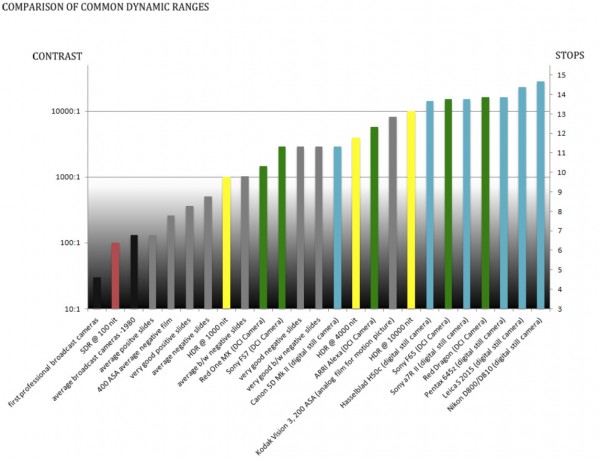
Florian Friedrich was the next speaker and is an occasional guest writer for Display Daily. As we reported recently on a visit to his AVTop company in Munich, he has worked a lot on HDR (AV-Top Exploring HDR & UltraHD in Munich).
His talk was about HDR10, which is a container for video with 10 bit video (HEVC), Rec.2020 colour space and the SMPTE 2084 (PQ) EOTF. There is HDR metadata in the video stream and it can be carried over HDMI 2.0a.
Displays with 10K cd/m² may not be important yet, but it’s good to have a container that can cover what is coming next. Because HDR10 also uses the Rec.2020 container, it means that you can store AdobeRGB or, more importantly, P3 within the stream. He recently went to an event on the future of HDR at Fox Studios in Hollywood and he said that colourists and content creators are very excited to be able to send really good content to the home.
Looking around the room, Friedrich said that we couldn’t encode the lighting and other dynamic range in the room with SDR. Even in an inside conference room you need HDR.
The real value of Rec.2020 is the container because it can cover P3 and almost everything a display will do in the future, but you don’t really need the single frequency primaries. Precisely covering P3 is very important for quality and metadata is also important.
Turning to the importance of PQ (SMPTE 2084), Friedrich showed a comparison of the curves of Rec.709 at 8-bit and how limited this is. He showed a nice chart with the contrast range of different cameras and film.
 The latest cameras have high dynamic range – Click for higher resolution
The latest cameras have high dynamic range – Click for higher resolution
The latest cameras can capture over 10,000:1 contrast, with more than 14 f stops of range: much more than film.
There are some factors that can influence the dynamic range, such as limits in the display brightness. If the display brightness is limited (and less than the PQ curve of up to 10K), you need to do tonemapping to map the signal to the display
Samsung has a set of test charts and measurements for the testing of HDR10 performance. Friedrich showed how it is used with test equipment from Spectracal to characterise displays. Friedrich had a chart of actual results. Because PQ has absolute values of brightness for each value, you can test reasonably easily. However, these are new areas and there is a lot of learning still to be done, even for experienced colourists with HDR.
The test patterns from Samsung can show how things can go wrong and it’s important to run test patterns through the full workflow.
There is still work to do to develop all the tools to support HDR. Even software such as DaVinci Resolve is not really set up for HDR – for example, it can show the code values, but not the light output from ST 2084.
Friedrich showed the software that he has developed for editing and manipulating HDR metadata.
Next he turned to the quality factors for HDR. There are new factors such as peak light output for specular highlights. Although TV makers think they don’t need very bright TVs, you do need it for peak brightness and specular highlights. Even colourists don’t want to make very bright large areas, but they do want highlights.
Friedrich has seen a big drop in white level in some TVs when there is some high peak illumination on the screen – down to as low as 150 cd/m² and then, in his opinion, it’s not an HDR display.
Summarising, HDR is important and Rec.2020 is needed. PQ is needed unless you can have 16-bit linear encoding (but that’s a long way away!)
In conclusion, HDR10 is a good standard for the next few years, in Friedrich’s view.
In response to a question (“If Rec.2020 is so important, why can’t you get content?”), Friedrich said that P3 can cover most of Pointer’s colours, so you don’t really need a Rec.2020 full gamut. In fact, P3 can cover not only most of Pointer’s colours, but also some artificial sources, such as the output of LEDs which are widely seen in townscapes, these days.

